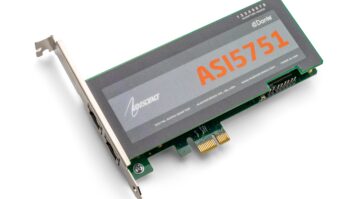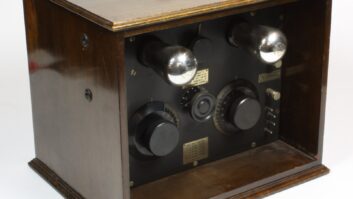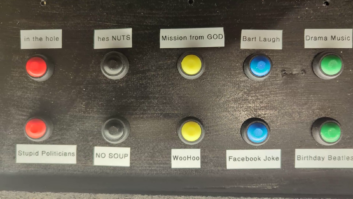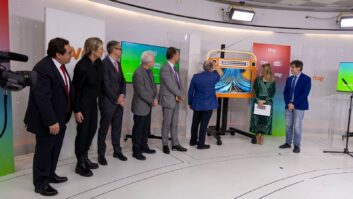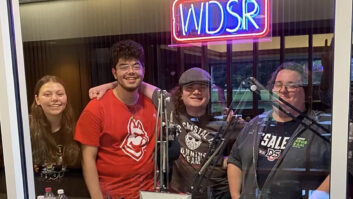
Fig. 1: Gary Morgan’s RDS kit from Pira. Consultant Stu Graham from Graham Brock Inc. was one of several engineers who said they enjoyed Harry Bingaman’s LED lighting strip solution (“Find Exactly the Lighting Aid You Need,” Feb. 1).
Stu questioned whether the strips could be put on a dimmer. Sunbury Broadcasting’s Harry Bingaman responded that, yes, light strips dim very nicely. Harry built a cute dimmer out of an NTE positive voltage regulator package and backlit a Christmas display for his mantle.
The best part: He had no AC outlet close, so he used a small gel cell to power the LEDs. Harry adjusted the voltage regulator for a nice warm glow.
The connection from the LEDs to the gel cell power pack is a cord with a 1/8-inch mono male plug to a female 1/8-inch chassis mount connector. This makes it easy to disconnect battery and regulator box for a recharge without disturbing the light strip. The battery life was substantial.
Harry wrote that he just got in three more reels of LED light strips. He adds that the most important part was that his wife just loved the finished project. This topic hit a nerve with the public, too; both Harry and I received numerous emails. Harry writes that this tip eclipsed interest in his LED hat, the one with white LEDs on the bill to help you see in dark areas.
* * *
Former CBS Charlotte Engineer Gary Morgan keeps his hands in the business, working for a few contract clients. Gary found a money-saving kit that he recommends for any frugal FM station.
Pira is a company in the Czech Republic that makes a series of affordable RDS/RBDS encoders. If you handle an FM station that plays music, there is no reason not to have an RDS signal displaying call letters, format and “now playing” information.
The smallest is the MicroRDS Encoder module, costing about $30. This module is a kit that can be put together in a couple of hours and works with the free Windows TinyRDS control software.

Fig. 2: The finished assembly. If you don’t have the time to solder, the company makes the Pira32 RDS Encoder module/complete box for around $200. The quality is excellent, Gary writes; they would be a nice addition to any FM station, but especially LPFMs and translators.
Fig. 1 shows the module board, mounted in an enclosure Gary built. It can sit on top of an FM exciter or audio processor, and as you can see from Fig. 2 of the completed unit, it runs off of a 5 VDC wall-wart.
The DB9 connector is connected to the serial port of a computer or laptop, and is used for programming and control. The TinyRDS software supports Windows versions 95 to 8.
Find Pira info at http://pira.cz/rds/.
* * *
Here’s a little tip from Radio America’s Alan Peterson. Lots of broadcasters depend on Skype, Ekiga, Goober and other VoIP services for outside remote events, where an Internet connection is easier to get than an ISDN line.
With an XLR-to-USB converter connecting a high-quality dynamic mic to a laptop computer, audio quality can be better than a G.722 connection.Often, though, the performer’s voice sounds as if it’s across the room, even if they are right on top of the mic. That’s because the VoIP software has selected the incorrect microphone — in most cases, the built-in electret mic in a laptop’s lid, which can be a good two feet or more away from the performer.
Since the level meter associated with the VoIP software will show deflection no matter which direction the talent speaks, it’s an easy thing to miss. If the connection was not tested anywhere beyond the cue speaker back in the studio, that first on-air hit over the big monitors comes as quite the disappointment.
To be sure which microphone is active, tap the standalone mic with a pencil and observe the meter. Then tap the upper edge of the laptop’s lid. The one with the strongest deflection is the active microphone. Change it in the software’s Setup or Options menu if necessary.
It will help too if the board-op back at the studio is listening to the test and can tell you immediately which is the stronger of the two.
A simple tip but one that is sure to make VoIP remotes sound better.Alan Peterson is production director for the Radio America Network in Arlington, Va.
Contribute to Workbench. You’ll help your fellow engineers and qualify for SBE recertification credit. Send tips to [email protected]. Fax to (603) 472-4944.
Author John Bisset has spent 43 years in the broadcasting industry and is still learning. He is SBE certified and is a past recipient of the SBE’s Educator of the Year Award.





